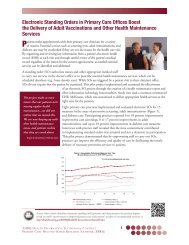Sustainability, Partnership, and Teamwork in Health IT Implementation
Sustainability, Partnership, and Teamwork in Health IT Implementation
Sustainability, Partnership, and Teamwork in Health IT Implementation
You also want an ePaper? Increase the reach of your titles
YUMPU automatically turns print PDFs into web optimized ePapers that Google loves.
Chapter 4. Other Cross-Organizational <strong>Partnership</strong>s<br />
for <strong>Health</strong> <strong>IT</strong> <strong>Implementation</strong><br />
KEY FINDINGS<br />
“The partnership aspect of the project was critical. Many organizations could not have a system like<br />
they do without hav<strong>in</strong>g the support of the group.” —A plann<strong>in</strong>g grantee<br />
● ● Of the 65 plann<strong>in</strong>g <strong>and</strong> implementation grant partnerships built or enhanced as a result of the<br />
plann<strong>in</strong>g <strong>and</strong> implementation grant opportunities, all but two cont<strong>in</strong>ued to work together <strong>in</strong><br />
part or <strong>in</strong> whole after the end of the grant period.<br />
● ● Helpful features of partnerships highlighted by grantees <strong>in</strong>cluded a shared view among partners<br />
that health <strong>IT</strong> is an enabler to a common goal (such as quality improvement), trust among<br />
partners, <strong>and</strong> <strong>in</strong>clud<strong>in</strong>g well-resourced organizations together with less-resourced partners.<br />
● ● <strong>Partnership</strong>s which <strong>in</strong>cluded at least one organization whose primary mission is not care delivery<br />
(such as a consultant, vendor, or professional association) were significantly more likely than<br />
others to report all partners cont<strong>in</strong>u<strong>in</strong>g to work together after the grant.<br />
● ● Small patient care delivery organizations reported benefit<strong>in</strong>g from partnerships by ga<strong>in</strong><strong>in</strong>g access<br />
to human resources they otherwise would have been unable to afford through shared staff<strong>in</strong>g<br />
models or technical support provided by larger partners.<br />
The THQ<strong>IT</strong> grant program required grantee organizations to partner with at least two other<br />
organizations to encourage the development of health <strong>IT</strong> that would result <strong>in</strong> the shar<strong>in</strong>g of cl<strong>in</strong>ical<br />
or research data across organizations. Moreover, plann<strong>in</strong>g <strong>and</strong> implementation grantees were<br />
encouraged to partner with small, rural hospitals <strong>and</strong> to <strong>in</strong>clude a variety of patient care delivery<br />
organizations <strong>in</strong> their partnership to stimulate health <strong>IT</strong> implementation <strong>in</strong> health care sett<strong>in</strong>gs that<br />
have historically lagged <strong>in</strong> implementation.<br />
We draw on the THQ<strong>IT</strong> grantee f<strong>in</strong>al reports <strong>and</strong> their responses to survey questions <strong>and</strong> qualitative<br />
<strong>in</strong>terviews to demonstrate how this partnership requirement may have facilitated implementation at<br />
smaller organizations, <strong>in</strong>creased participation <strong>in</strong> HIE activities, <strong>and</strong> encouraged future collaboration.<br />
Most commonly, respondents from the lead grantee organization completed the survey <strong>and</strong>, when<br />
applicable, the <strong>in</strong>terview. Only two grantees had respondents participate from multiple partners: the<br />
lead grantee organization <strong>and</strong> another participat<strong>in</strong>g patient-care delivery organization. Thus, the<br />
<strong>in</strong>formation presented on partnerships may not reflect the perspective all partner organizations. To<br />
provide appropriate context, we first describe who participated <strong>in</strong> the THQ<strong>IT</strong> partnerships. We then<br />
outl<strong>in</strong>e four strategies that grantees used to build last<strong>in</strong>g relationships between partners, <strong>and</strong> describe<br />
how those relationships benefited the participat<strong>in</strong>g organizations.<br />
Who Participated <strong>in</strong> the THQ<strong>IT</strong> <strong>Partnership</strong>s?<br />
The partnerships formed by organizations funded under the THQ<strong>IT</strong> program ranged <strong>in</strong> scale <strong>and</strong><br />
<strong>in</strong>cluded a wide variety of organizations that deliver patient care, as well as organizations that do not<br />
deliver care. Most projects focused on either one (31 percent) or two (31 percent) types of patient care<br />
delivery organizations, with hospitals <strong>and</strong> physician practices the most likely types of organizations<br />
35<br />
Chapter 4. Other Cross-Organizational <strong>Partnership</strong>s for <strong>Health</strong> <strong>IT</strong> <strong>Implementation</strong>

















